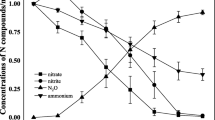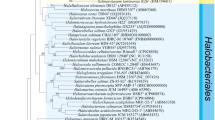Abstract
Two haloalkaliphilic bacteria isolated from industrial brine solutions were characterized via molecular, physiological, and in silico metabolic pathway analyses. Genomes from the organisms, designated Halomonas BC1 and BC2, were sequenced; 16S ribosomal subunit-based phylogenetic analysis revealed a high level of similarity to each other and to Halomonas meridiana. Both strains were moderate halophiles with near optimal specific growth rates (≥60 % μ max) observed over <0.1–5 % (w/v) NaCl and pH ranging from 7.4 to 10.2. Isolate BC1 was further characterized by measuring uptake or synthesis of compatible solutes under different growth conditions; in complex medium, uptake and accumulation of external glycine betaine was observed while ectoine was synthesized de novo in salts medium. Transcriptome analysis of isolate BC1 grown on glucose or citrate medium measured differences in glycolysis- and gluconeogenesis-based metabolisms, respectively. The annotated BC1 genome was used to build an in silico, genome-scale stoichiometric metabolic model to study catabolic energy strategies and compatible solute synthesis under gradients of oxygen and nutrient availability. The theoretical analysis identified energy metabolism challenges associated with acclimation to high salinity and high pH. The study documents central metabolism data for the industrially and scientifically important haloalkaliphile genus Halomonas.





Similar content being viewed by others
References
Aston JE, Peyton BM (2007) Response of Halomonas campisalis to saline stress: changes in growth kinetics, compatible solute production and membrane phospholipid fatty acid composition. FEMS Microbiol Lett 274:196–203
Ates O, Oner ET, Arga KY (2011) Genome-scale reconstruction of metabolic network for a halophilic extremophile, Chromohalobacter salexigens DSM 3043. BMC Syst Biol 5:12
Beck A, Hunt KA, Bernstein HC, Carlson RP (2016) Interpreting and designing microbial communities for bioprocess applications, from components to interactions to emergent properties. Biotechnol Biofuel Prod Optim 1:407–432
Benjamini Y, Hochberg Y (1995) Controlling the false discovery rate: a practical and powerful approach to multiple testing. J R Stat Soc B Methodol 57:289–300
Biegel E, Schmidt S, González JM, Müller V (2011) Biochemistry, evolution and physiological function of the Rnf complex, a novel ion-motive electron transport complex in prokaryotes. Cell Mol Life Sci 68:613–634
Booth IR (1985) Regulation of cytoplasmic pH in bacteria. Microbiol Rev 49:359–378
Bott M (1997) Anaerobic citrate metabolism and its regulation in enterobacteria. Arch Microbiol 167:78–88
Brown AD (1976) Microbial water stress. Bacteriol Rev 40:803–846
Bursy J, Pierik AJ, Pica N, Bremer E (2007) Osmotically induced synthesis of the compatible solute hydroxyectoine is mediated by an evolutionarily conserved ectoine hydroxylase. J Biol Chem 282:31147–31155
Carlson RP (2007) Metabolic systems cost-benefit analysis for interpreting network structure and regulation. Bioinformatics 23:1258–1264
Carlson RP (2009) Decomposition of complex microbial behaviors into resource-based stress responses. Bioinformatics 25:90–97
Carlson RP, Taffs RL (2010) Molecular-level tradeoffs and metabolic adaptation to simultaneous stressors. Curr Opin Biotechnol 21:670–676
Carlson R, Wlaschin A, Srienc F (2005) Kinetic studies and biochemical pathway analysis of anaerobic poly-(R)-3-hydroxybutyric acid synthesis in Escherichia coli. Appl Environ Microbiol 71:713–720
Delcher AL, Bratke KA, Powers EC, Salzberg SL (2007) Identifying bacterial genes and endosymbiont DNA with Glimmer. Bioinformatics 23:673–679
Dimroth P, Jockel P, Schmid M (2001) Coupling mechanism of the oxaloacetate decarboxylase Na+ pump. BBA Bioenerg 1505:1–14
Evans AM, DeHaven CD, Barrett T, Mitchell M, Milgram E (2009) Integrated, nontargeted ultrahigh performance liquid chromatography/electrospray ionization tandem mass spectrometry platform for the identification and relative quantification of the small-molecule complement of biological systems. Anal Chem 81:6656–6667
Folsom JP, Parker AE, Carlson RP (2014) Physiological and proteomic analysis of Escherichia coli iron-limited chemostat growth. J Bacteriol 196:2748–2761
Giordano A, Vella FM, Romano I, Gambacorta A (2007) Structural elucidation of a novel phosphoglycolipid isolated from six species of Halomonas. J Lipid Res 48:1825–1831
Goto T, Matsuno T, Hishinuma-Narisawa M, Yamazaki K, Matsuyama H, Inoue N, Yumoto I (2005) Cytochrome c and bioenergetic hypothetical model for alkaliphilic Bacillus spp. J Biosci Bioeng 100:365–379
Grammann K, Volke A, Kunte HJ (2002) New type of osmoregulated solute transporter identified in halophilic members of the bacteria domain: TRAP transporter TeaABC mediates uptake of ectoine and hydroxyectoine in Halomonas elongata DSM 2581T. J Bacteriol 184:3078–3085
Grant WD (2004) Life at low water activity. Philos Trans R Soc B 359:1249–1266
Guzman H, Van-Thuoc D, Martin J, Hatti-Kaul R, Quillaguaman J (2009) A process for the production of ectoine and poly(3-hydroxybutyrate) by Halomonas boliviensis. Appl Microbiol Biotechnol 84:1069–1077
Halverson LJ, Jones TM, Firestone MK (2000) Release of intracellular solutes by four soil bacteria exposed to dilution stress. Soil Sci Soc Am J 64:1630–1637
Horikoshi K (1999) Alkaliphiles: some applications of their products for biotechnology. Microbiol Mol Biol Rev 63:735–750
Kempf B, Bremer E (1998) Uptake and synthesis of compatible solutes as microbial stress responses to high-osmolality environments. Arch Microbiol 170:319–330
Kieft TL, Soroker E, Firestone MK (1987) Microbial biomass response to a rapid increase in water potential when dry soil is wetted. Soil Biol Biochem 19:119–126
Klamt S, Saez-Rodriguez J, Gilles ED (2007) Structural and functional analysis of cellular networks with CellNetAnalyzer. BMC Syst Biol 1:2
Krulwich TA, Ito M, Gilmour R, Sturr MG, Guffanti AA, Hicks DB (1996) Energetic problems of extremely alkaliphilic aerobes. BBA Bioenerg 1275:21–26
Kuhlmann SI, Terwisscha van Scheltinga AC, Bienert R, Kunte HJ, Ziegler C (2008) 1.55 Å structure of the ectoine binding protein TeaA of the osmoregulated TRAP-transporter TeaABC from Halomonas elongata. Biochemistry 47:9475–9485
Kushner DJ (1978) Life in high salt and solute concentrations: halophilic bacteria. In: Kushner DJ (ed) Microbial life in extreme environments. Academic Press, London, pp 317–368
Kushner DJ, Kamekura M (1988) Physiology of halophilic eubacteria. Halophilic Bact 1:109–140
Mothes G, Schubert T, Harms H, Maskow T (2008) Biotechnological coproduction of compatible solutes and polyhydroxyalkanoates using the genus Halomonas. Eng Life Sci 8:658–662
Neidhardt FC, Ingraham JL, Schaechter M (1990) Physiology of the bacterial cell: a molecular approach. Sinauer Associates, Sunderland, MA
Oren A (1999) Bioenergetic aspects of halophilism. Microbiol Mol Biol Rev 63:334–348
Oren A (2008) Microbial life at high salt concentrations: phylogenetic and metabolic diversity. Saline Syst 4:2
Oren A (2011) Thermodynamic limits to microbial life at high salt concentrations. Environ Microbiol 13:1908–1923
Pade N, Köcher S, Roessler M, Hänelt I, Müller V (2013) Bioenergetics of the moderately halophilic bacterium Halobacillus halophilus: composition and regulation of the respiratory chain. Appl Environ Microbiol 79:3839–3846
Pastor JM, Bernal V, Salvador M, Argandona M, Vargas C, Csonka L, Sevilla A, Iborra JL, Nieto JJ, Canovas M (2013) Role of central metabolism in the osmoadaptation of the halophilic bacterium Chromohalobacter salexigens. J Biol Chem 288:17769–17781
Petersen J, Forster K, Turina P, Graber P (2012) Comparison of the H+/ATP ratios of the H+-ATP synthases from yeast and from chloroplast. PNAS 109:11150–11155
Roberts MF (2005) Organic compatible solutes of halotolerant and halophilic microorganisms. Saline Syst 1:5
Schuster S, Hilgetag C (1994) On elementary flux modes in biochemical reaction systems at steady state. J Biol Syst 2:165–182
Schuster R, Schuster S (1993) Refined algorithm and computer program for calculating all non-negative fluxes admissible in steady states of biochemical reaction systems with or without some flux rates fixed. Bioinformatics 9:79–85
Schuster S, Fell DA, Dandekar T (2000) A general definition of metabolic pathways useful for systematic organization and analysis of complex metabolic networks. Nat Biotechnol 18:326–332
Schwibbert K, Marin-Sanguino A, Bagyan I, Heidrich G, Lentzen G, Seitz H, Rampp M, Schuster SC, Klenk HP, Pfeiffer F, Oesterhelt D, Kunte HJ (2011) A blueprint of ectoine metabolism from the genome of the industrial producer Halomonas elongata DSM 2581. Environ Microbiol 13:1973–1994
Sherwood JE, Stagnitti F, Kokkinn MJ, Williams WD (1991) Dissolved-oxygen concentrations in hypersaline waters. Limnol Oceanogr 36:235–250
Smyth GK (2004) Linear models and empirical Bayes methods for assessing differential expression in microarray experiments. Stat Appl Genet Mol Biol 3:3
Smyth GK (2005) Limma: linear models for microarray data. Bioinformatics and computational biology solutions using R and bioconductor. Springer, New York, pp 397–420
Steigmiller S, Turina P, Graeber P (2008) The thermodynamic H+/ATP ratios of the H+-ATPsynthases from chloroplasts and Escherichia coli. PNAS 105:3745–3750
Steuber J, Schmid C, Rufibach M, Dimroth P (2000) Na+ translocation by complex I (NADH:quinone oxidoreductase) of Escherichia coli. Mol Microbiol 35:428–434
Tamura K, Stecher G, Peterson D, Filipski A, Kumar S (2013) MEGA6: molecular evolutionary genetics analysis version 6.0. Mol Biol Evol 30:2725–2729
Thompson JD, Higgins DG, Gibson TJ (1994) CLUSTAL W: improving the sensitivity of progressive multiple sequence alignment through sequence weighting, position-specific gap penalties and weight matrix choice. Nucl Acids Res 22:4673–4680
Trinh CT, Wlaschin A, Srienc F (2009) Elementary mode analysis: a useful metabolic pathway analysis tool for characterizing cellular metabolism. Appl Microbiol Biotechnol 81:813–826
Ventosa A, Nieto JJ, Oren A (1998) Biology of moderately halophilic aerobic bacteria. Microbiol Mol Biol Rev 62:504–544
Verkhovsky MI, Bogachev AV (2010) Sodium-translocating NADH: quinone oxidoreductase as a redox-driven ion pump. BBA 1797:738–746
Acknowledgments
The authors are grateful for the financial assistance of Procter and Gamble, Inc. and appreciate the contributions of Adam Kennedy and colleagues at Metabolon, Inc. The authors would also like to thank Ryan Jennings, Ashley Beck and Kristopher Hunt for critical reading of the manuscript and 16S rRNA analysis.
Author information
Authors and Affiliations
Corresponding authors
Additional information
Communicated by A. Oren.
Electronic supplementary material
Below is the link to the electronic supplementary material.
Rights and permissions
About this article
Cite this article
Carlson, R.P., Oshota, O., Shipman, M. et al. Integrated molecular, physiological and in silico characterization of two Halomonas isolates from industrial brine. Extremophiles 20, 261–274 (2016). https://doi.org/10.1007/s00792-015-0806-6
Received:
Accepted:
Published:
Issue Date:
DOI: https://doi.org/10.1007/s00792-015-0806-6




